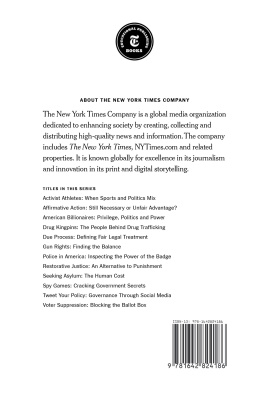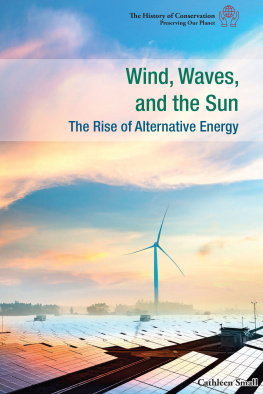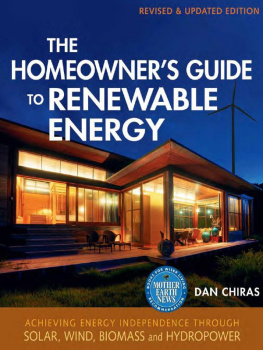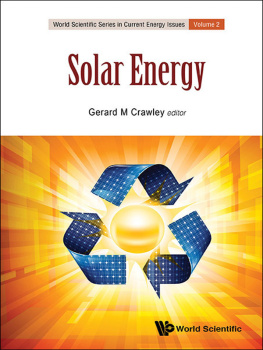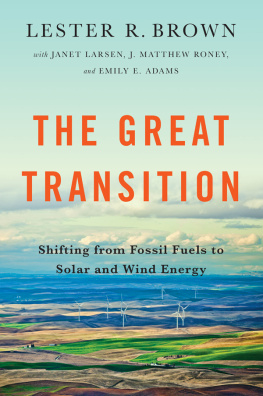Published in 2020 by New York Times Educational Publishing in association with The Rosen Publishing Group, Inc. 29 East 21st Street, New York, NY 10010
Contains material from The New York Times and is reprinted by permission. Copyright 2020 The New York Times. All rights reserved.
Rosen Publishing materials copyright 2020 The Rosen Publishing Group, Inc. All rights reserved. Distributed exclusively by Rosen Publishing.
First Edition
The New York Times
Alex Ward: Editorial Director, Book Development
Phyllis Collazo: Photo Rights/Permissions Editor
Heidi Giovine: Administrative Manager
Rosen Publishing
Megan Kellerman: Managing Editor
Greg Clinton: Editor
Greg Tucker: Creative Director
Brian Garvey: Art Director
Cataloging-in-Publication Data
Names: New York Times Company.
Title: Energy technology: the tools of the industry / edited by the New York Times editorial staff.
Description: New York : New York Times Educational Publishing, 2020. | Series: Looking forward | Includes glossary and index.
Identifiers: ISBN 9781642822632 (library bound) | ISBN 9781642822625 (pbk.) | ISBN 9781642822649 (ebook)
Subjects: LCSH: Power resourcesJuvenile literature. | Energy developmentEnvironmental aspectsJuvenile literature. | Technological innovationsJuvenile literature. | Renewable energy sourcesJuvenile literature.
Classification: LCC TJ163.23 E547 2020 | DDC 621.042dc23
Manufactured in the United States of America
On the cover: A 3-D drilling simulator, an advanced tool to teach students at the Saudi Aramco Upstream Professional Development Center in Dharhan, Saudi Arabia, Jan. 10, 2018; Christophe Viseux/The New York Times.
Introduction
THE SUN IS the origin of all the energy trapped on Earth in various forms: heat, matter, wind and motion. From the beginning, the story of human society and industry has been the ever more efficient and powerful harnessing of energy technology. Energy is possibility. In the form of fossil fuels petroleum, coal and its variants energy technologies such as the internal combustion engine drove the Industrial Revolution. Nuclear energy has shaped the planet both economically and politically, creating a singular world order of nuclear armed nations and at the same time producing relatively safe in the short term, at least and cheap electricity.
But the dream has always been to harness the forces of the sun itself, whether through some kind of controlled nuclear fusion reaction, mimicking the stars themselves, or more practically through technologies that collect and convert sunlight, heat and wind into useful electrical current. These solar-based systems are sustainable and renewable, two terms one might read often in a discussion of energy and that speak to the heart of the urgency of this issue.
Since the Industrial Revolution and the dawn of mass production, on average, life has gotten better for human beings as a species, but growth has led to widespread pollution and the destruction of natural resources. Once oil or coal is extracted and burned for fuel, it becomes part of a chain of events that we now call global warming, or more broadly, climate change. Fossil fuels are unsustainable; in the end, at the scale with which we are deploying them, they will ruin the planet. Nuclear fuels are expensive and a security threat, and they contribute to pollution problems over the long term. We need a solar-based alternative as soon as possible.

Seen in reflection, Duke Energys Top of the World wind farm near Glenrock, Wyo., Sept. 15, 2017. Four large wind farms have been built in recent years, and expansions are on the way.
While this argument might seem relatively straightforward, the politics of energy are complex and heated, especially in the United States, where energy production is linked to different cultural and social traditions: the generations of coal miners who see their way of life dying out, the families whose houses happen to sit on millions of dollars worth of shale gas ready for extraction, the communities in Alaska who either want to profit from oil drilling or believe it will destroy the states valuable wilderness.
Americans have faced an array of tricky questions regarding energy and its production: Should we buy oil from our political rivals, thereby enriching them and making us beholden to them? How far are we willing to go to get cheap sources of energy? Far enough to join a war? How important is the environment weighed against social, political and economic strength? There are no easy answers.
The following pages contain an array of energy stories about nuclear fission, oil extraction and pollution, the hunt for efficient solar energy, wind and geothermal technologies and more. Each of these stories has unique implications for the future of energy use, but they all intersect in their impact on climate change and the reality the human species will face in the future.
CHAPTER 1
The Long Dream of Clean Energy
It may be surprising to learn that engineers and scientists have been dreaming about harnessing solar energy for centuries. At each stage of development, from early mechanical engineering efforts to modern solar energy infrastructure, the dream of cheap, clean energy has connected with political and social goals: to avoid war over scarce resources, to allow everyone to live a high-quality life and to use the vast renewable power at our disposal to create new and innovative technologies that will improve life on Earth. In these articles, the sense of excitement and promise is palpable. But so too is the sense of urgency, especially in the 21st century, when industrial-fueled climate change is taking full effect and clean energy solutions have become more necessary.
New Solar Engine Gives Cheap Power
BY WILLIAM L. LAURENCE | DEC. 30, 1935
ST. LOUIS, DEC. 29. The most efficient apparatus so far developed by man for the direct conversion of the rays of the sun into useful mechanical energy was demonstrated here today at the scientific exhibit of the American Association for the Advancement of Science, which opens its annual Winter meeting tomorrow.
The latest model of the solar engine makes another dream of science a practical reality. It was developed and displayed here by Dr. C. G. Abbott, secretary of the Smithsonian Institution, Washington, who has devoted many years of his life to efforts to devise means for harnessing the suns limitless energy for the use of man.
His latest sun-trap, Dr. Abbott said, constitutes a vast advance over the model he displayed last year. So efficient is it, he stated, that it is merely a question of comparative cost whether it should be used immediately for practical purposes.
As far as the apparatus is concerned, he added, the problem of converting solar radiation into useful energy has at last been solved.
CITES INEXHAUSTIBLE POWER.
The means are available right now, he went on, power from the sun in inexhaustible amounts, and all parts of the earth. It is merely a question of cost whether it can be obtained as cheaply as power from coal, oil and gas.





